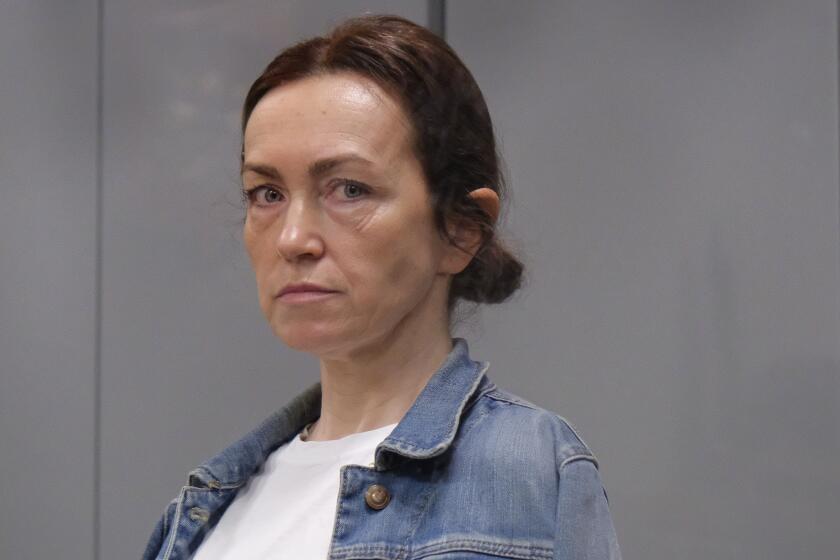COLUMN ONE : Champion of the Legal Lost Cause : Gerry Spence made his reputation taking on ‘unwinnable’ cases. Defending Imelda Marcos may be his biggest gamble yet.
For a moment, the heavy spring snowfall obscured the views of skyscrapers beyond his apartment window, reminding Gerry Spence of home. Wyoming. The ranch. The natural habitat of a lawyer who wears a 10-gallon Stetson to court.
But there was no sign of a Grand Teton forest outside this glass. Not here, five floors above East 47th Street.
“Look at that.” He pointed down at the street, into the shadows of the urban towers toward a small concrete plaza. It was a single budding tree. He pondered the hint of green on the city’s otherwise gray, wet landscape.
“I think that’s the first tree I’ve seen in this town.”
Gerry Spence, 61, the cowboy lawyer who’s here to defend exiled Philippine first lady Imelda Marcos against federal fraud and racketeering charges, is finding out just how far away he is from Jackson and the sanctuary of Wyoming cottonwoods.
He was never farther from home than during last week’s opening round of his first trial in New York. Foul weather and angry insults greeted his arrival with Mrs. Marcos at the steps to the federal courthouse. Nor did his homespun, country style hold up well inside, in a courtroom with more pinstripe than buckskin.
Spence clashed with the judge, suffered damaging surprises at the hands of a skilled prosecution team and stumbled so badly once during his opening statements that he appeared to insult, of all people, the jury.
It was, he conceded, “the worst opening” of his long and storied career.
A three-month case, or longer, as this is almost certain to be, leaves plenty of time to recover--”to dig out of this damn deep hole.”
But Spence’s biggest obstacles aren’t likely to be his early blunders so much as the massive documentary evidence that supports the government’s criminal charges, the hundreds of thousands of pages of bank records, telexes, receipts, memos, contracts and reports that federal prosecutors say tell a story of thievery “on an incredible scale.”
Another substantial dilemma is the specter of Ferdinand E. Marcos. Some of the government’s strongest evidence implicates the dead dictator, making the safest defense for his widow the “ignorant wife defense.” But Mrs. Marcos, still dressed in mourning black, won’t have her lawyer shifting blame on her late husband.
“This is a woman who believes her husband was totally innocent of the charges that were made here,” Spence told the crowded court last week, in a dramatic preamble to his ill-fated opening statement.
Outside, a rainstorm raged, and a loud wind howled through partially opened windows. Spence raised his baritone volume above the eerie din: “He’s dead. His lips have been sealed by death. He can’t defend himself.”
Then, stepping beside the tearful Mrs. Marcos, he spoke for her as he proclaimed: “You can do what you wish with me, but . . . you cannot do this to that great man, she says, and I want you to defend him--and so we will.”
Unique Arguments
But brave rhetoric masks a troubled case. Faced with often overwhelming factual evidence, Spence is left making some rather novel defense arguments concerning intent and motivation. For example:
--About allegations the Marcoses looted the Philippine treasury by transferring public funds to secret bank accounts around the world and making hidden investments in New York real estate: Spence told jurors the money was actually being invested overseas as a contingency fund to finance a return to power if the Philippines fell to communist insurgents. He said creation of what was “loosely referred to as a communist takeover fund” was all done with the knowledge and encouragement of the CIA and then-Vice President George Bush.
--About allegations of bribes and kickbacks: Spence told the jury that what looks like a kickback in America was, in the Philippines, actually a sort of “tax” or user fee that President Marcos extracted from “those industries that would most benefit from the communists not taking over the country. . . . Large corporations. He made them pay.”
--About allegations that the Marcoses defrauded their country and then exported the fruits of that fraud to New York and California: Spence told jurors the Marcoses could not have broken the laws of the Philippines since Marcos wrote those laws. After declaring martial law in 1972, Marcos ruled by decree. “What he was doing in the Philippines was done in accordance with his law since he was the law.”
--About allegations that Imelda Marcos used the national treasury to finance shopping sprees for jewelry, art and shoes: Spence said the image of “this obscene, ugly spender, this greedy person who couldn’t be satisfied with a few pairs of shoes,” is the fiction of vicious media. He told jurors that much of her spending was to acquire gifts for foreign dignitaries and souvenirs to take home to thousands of local officials in the Philippines. And most of the shoes, gifts from shoemakers, “weren’t her size.”
Defending Lost Causes
The hallmark of Gerry Spence’s legal career has been the lost cause, the unwinnable case.
He once took on a client who had shot his ex-wife in front of eight witnesses just to prove that he could win a case with someone “so obviously guilty that the public will demand he be hauled away without even a trial.”
It took several years and multiple trials, but Spence eventually won acquittal arguing that the man had been, but was no longer, insane. The client was free for nearly a year before he was killed when he tried to kill another man.
Spence’s national reputation was made in 1979 when he won an initial $10.5-million civil damage award from energy conglomerate Kerr-McGee Corp. on behalf of the family of Karen Silkwood. Many years later it was reduced to $1.38 million.
(Silkwood, a laboratory analyst at the company’s Crescent, Okla., nuclear plant who had been protesting what she viewed as sloppy practices in handling plutonium, died in a one-car accident in 1974 while reportedly on her way to deliver incriminating documents to a New York Times reporter. The documents were never found.)
Spence, arguing with towering rhetoric, told jurors she was “married to cancer” because of her plutonium exposure. He repeatedly referred to attorneys for Kerr-McGee as “the men in gray.”
It was classic Spence: converting the legal conflict to an emotional and moral contest between the good guys and the bad guys, between the Christians and the gladiators, between “the little people” and the “greedy corporations.”
As a young lawyer he had worked for insurance companies, defending them against liability claims. It wasn’t quite what his mother had in mind for him--she wanted him to pursue a gospel ministry. Instead he pursues “the divine mist” of justice.
Something akin to a religious experience dramatically altered Spence’s legal career. He compares it with Saul’s conversion on the road to Damascus.
He was in a supermarket when he encountered a man who had been injured by a drunk driver. Spence, representing an insurance company, had fought the man’s damage claim, and won.
But Spence couldn’t savor his legal triumph in that grocery aisle. All he saw was a crippled old man. The next morning he decided: “I’m quitting the insurance business.”
It has been a lucrative conversion. He has won staggering jury awards.
In 1984 he won a $52-million verdict against the McDonald’s Corp. hamburger chain for a vendor after the chain declined to honor an oral contract to buy his ice cream. (It later was settled for $15.5 million). His clients have won numerous judgments ranging from $3 million to $5 million. One of those, a $4.75-million malpractice verdict against a Utah physician, also changed the nursing standards of that state, giving nurses more rights to intercede when they witness improper treatment by a doctor.
Spence also got a federal court in Cheyenne to award the 1978 Miss Wyoming $26.5 million in a libel suit against Penthouse magazine. That was his earliest huge judgment, making him a much sought after plaintiff’s attorney. The award was reversed on appeal, but Spence has never been short of clients since.
For civil litigation, he commands hefty contingency fees, as much as 50%, but most of his criminal defense work is pro bono, free.
‘Lone Ranger Lawyer’
As a champion of plaintiffs hopelessly outgunned by adversaries with big corporate legal staffs or defendants unable to afford a first-rate attorney, someone dubbed Spence “the Lone Ranger lawyer,” riding to the rescue of the little people. He once sent a rival attorney a package of legal documents that included a single silver bullet. Critics accuse him of sometimes turning legal proceedings “into horse operas.”
One reward for his success and notoriety is freedom. Spence can be picky about his clients.
“A lawyer who has a choice ought not take cases he can’t get his guts into. You gotta love your client. A jury can soon tell if you care. They won’t if you don’t.”
He has avoided celebrity clients, looking instead to be the hired gun of the underdog.
So it came as a surprise to some when Spence took the case of Imelda Marcos, once among the richest and most powerful women in the world. Even now, living in luxurious exile in Hawaii, she can hardly be called one of “the little people.”
Yet, Spence sees Mrs. Marcos differently, through a prism provided by his wife, Imaging. “She told me to think about how lonely (Mrs. Marcos) must be--her husband dead, she’s in a strange country, in a great deal of trouble.”
With Imaging’s encouragement Spence flew to Honolulu and met what he calls “a very decent and courageous woman.” He took her case for a fee, which he will not discuss. Now Spence rides to her defense in court, on camera and on the streets of New York.
No picture of Mrs. Marcos on the courthouse steps is taken without the woman in black holding the strong arm of the 6-foot, 2-inch cowboy in the tall Stetson.
“Why can’t you treat her as a human being?” he demands of reporters whose coverage of the Marcoses has been, he says, “vicious and unfair.” He paces his apartment angrily considering the morning headlines strewn across a coffee table.
“This woman has become a public sacrificial lamb for the media.”
He snatches the tabloid copy of New York Newsday, gripping it as he would a villain seized by the throat. “Did you see this?”
The front page is dominated by a picture of Mrs. Marcos under the one-word banner headline: “OINK.”
It’s a story about allegations she used a Philippine bank branch in New York as her “personal piggy bank.” Spence is not amused.
“A headline like that hurts me. I look at that and feel physical pain.”
Imelda Marcos will probably make the long walk from the defense table to the witness chair before her trial is over. Spence says it may be the only way to show the jury that “this lady, this caricature of greed and evil, is a good and decent human being.”
But he concedes the risk.
Defense lawyers are naturally reluctant to turn over their clients, guilty or innocent, to the cross-examination of a prosecutor. Spence has instructed some of his clients to keep a low profile even at the defense table, suggesting to one murder client for whom he was seeking a finding of insanity that he simply stare at his shoes through the entire trial.
“What a terrible place to have to show who you are: in a courtroom of people leering at you. A judge looking down on you. You can’t tell your story, you can only answer questions. And you’re cross-examined by someone who hates you and wants to destroy you.”
Already, Spence is trying to put the black hat on the government prosecutors, casting them as persecutors of a lonely widow.
“A trial should be a search for the truth.” Instead, he says, it’s a search for obscure documents in a library of evidence. Spence has been on the Marcos case only a few months and is clearly frustrated by the daunting bulk of investigative material.
“Finding what we need in all that is like looking for a marble in a gravel truck.”
Last week his incomplete knowledge of the documents could have been responsible for his stumbling into areas of cross-examination that permitted prosecutor Charles LaBella to introduce surprising and damaging follow-up testimony. In one case, a witness said he was physically threatened by a Marcos confidante to protect the first lady’s business secrets; another, a Marcos banker, said the late dictator tried to curb his wife’s free spending habits by ordering government banks to stop giving her money.
He also is up against a very well-prepared prosecution team.
LaBella, 39, who directed the federal investigation since 1987, and his associate, Debra Livingston, 31, had to contend with White House and State Department considerations to get the politically sensitive indictment in the first place. They bring the same kind of passion to the prosecution that Spence brings to the defense. And, so far, they know the evidence better.
One question mark has to be the appeal of the Spence style and rhetoric to a New York jury. It would seem he can only improve on his opening day performance.
“This is my first trial in New York,” he told jurors in his introduction. “I am a long ways from home. And I am going to make some mistakes.”
He was right.
Spence ignored Judge John F. Keenan’s increasingly sharp warnings to talk about the evidence of the case and instead set out to tell his version of the story of Imelda Marcos: victim of World War II atrocities, witness to beheadings, wounded in the war, there when MacArthur returned, sang “God Bless the Philippines” to Irving Berlin, drank water out of foxholes. . . .
Sustained objections rained down like the storm outside the courtroom.
Finally, Spence went too far for Keenan. The lawyer started to tell the jury that Mrs. Marcos “certainly . . . is not being provided in this case with a jury of her peers anymore than, I suppose . . .”
Livingston was on her feet, objecting. Keenan barked: “Sustained!” into his desktop microphone and then addressed the jury emphatically:
“You are a jury of her peers. Under the laws of the United States and the Constitution of the United States you are properly sworn to judge this case and to decide and pass upon the guilt or innocence both of Mrs. Marcos and Mr. (Adnan) Khashoggi (her co-defendant).”
Spence could only stand and wait, his potentially insulting proposition left dangling, as the judge continued:
“That’s why we took five days to pick the jury and did it as carefully as we did.”
Finally, it was Spence’s turn again. He had to explain even if it risked angering the judge again. He spoke contritely.
“Ladies and gentlemen of the jury, I don’t mean to suggest you are not a proper jury. She wants to be tried by you. I don’t mean that at all. But it is like Mrs. Bush being tried by a Philippine jury.”
“Objection!”
“Sustained. Desist from that, sir!”
Gerry Spence remembers his first fight. He was a boy, “chosen out,” in the parlance of the playground. Challenged to an adolescent duel.
“I was afraid to fight; I was afraid to run. I just had to think about it all day until school was out and then go face it. It was the longest day I’d ever known.”
He’s had many “longest days” since. Every trial, every day in court, is like that first boyhood test of nerve. “There’s still a scared little lawyer inside me.”
Except now the stakes are higher.
A criminal case, whether in Wyoming or New York, is “deadly combat,” he says. The prize for success is the same in country courts or the city:
The winner “gets to keep the defendant.”
And when the lawyer in the Stetson heads west again at the end of this trial, he intends to be riding into the sunset with the dictator’s widow.
Staff writer Henry Weinstein in Los Angeles contributed to this story.
More to Read
Sign up for Essential California
The most important California stories and recommendations in your inbox every morning.
You may occasionally receive promotional content from the Los Angeles Times.






